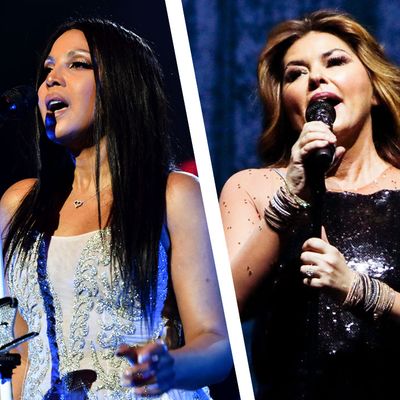
SundayÔÇÖs American Music Awards will be packed with sets from the big-name artists youÔÇÖd expect to see at a 2019 award show, including Lizzo, Camila Cabello, Billie Eilish, Post Malone, and yes, Taylor Swift. But the ABC telecast will also include performances from three acts that first hit the Billboard charts way back before the launch of Windows 95: Rockers Green Day, R&B diva Toni Braxton, and country crossover crooner Shania Twain. ThereÔÇÖs nothing unusual about awards shows finding some time to spotlight the past, but whatÔÇÖs relatively new is the extent to which music industry kudocasts are leaning into nostalgia as a weapon against ratings erosion.
This trend toward embracing the past has developed over the past few years, says Mark Bracco, exec VP of programming and development at Dick Clark Productions, the company that produces the AMAs and several other big awards shows. Bracco says they started adding more old-school content a few years ago, most notably in 2015 when the Billboard Music Awards brought back Simple Minds to sing ÔÇ£DonÔÇÖt You (Forget About Me)ÔÇØ to mark the 30th anniversary of the songÔÇÖs release and famous use in The Breakfast Club. The performance was a smash on social media and it led Dick Clark Productions to weave more retro moments into the shows it produces. In 2017, Celine Dion marked the 20th anniversary of her Titanic theme by belting out ÔÇ£My Heart Will Go OnÔÇØ at the BBMAs. For last yearÔÇÖs show, Salt-N-Pepa did a medley to celebrate being the first female rappers to hit No. 1 on the charts, recruiting fellow retro act En Vogue to help out. And in May, this yearÔÇÖs BBMAs included showstoppers from ÔÇÖ90s icons Mariah Carey and Paula Abdul.
While Carey has been churning out hits well into the 21st century, Abdul long ago left the Billboard charts in favor of reality-TV roles like serving as a judge on American Idol. But that didnÔÇÖt matter when she stepped onstage in Las Vegas. ÔÇ£It brought the house down,ÔÇØ Bracco says. ÔÇ£People loved it.ÔÇØ┬áAnd heÔÇÖs not just talking about the audience at the MGM Grand Garden Arena or the ever-enthusiastic crowds on Twitter. Bracco says Abdul and CareyÔÇÖs set actually moved the Nielsen needle, something Dick Clark Productions has seen with other recent retro segments. ÔÇ£These performances by people like Paula Abdul or Celine Dion, they are spiking in those minute-by-minute [ratings],ÔÇØ he explains. ÔÇ£Christina Aguilera doing the tribute to The Bodyguard on the AMAs was a huge spike. When we gave Diana Ross the Lifetime Achievement Award a couple of years ago on the AMAs and she did this eight-and-a-half-minute medley of all her greatest hits, it spiked through the roof.ÔÇØ
Two years ago, Dick Clark Productions also added more nostalgia to its production of the Academy of Country Music Awards, introducing ÔÇ£ACM FlashbacksÔÇØ segments, in which legacy artists team up with newer acts to perform classic songs. TheyÔÇÖre not the only ones riding the retro bandwagon: Last week, the rival Country Music Awards, produced by Robert Deaton, was packed with blasts from the past, from a star-studded salute to female performers featuring Crystal Gayle, Tanya Tucker, and Dolly Parton to a pairing of Willie Nelson with Kacey Musgraves for a cover of ÔÇ£Rainbow Connection.ÔÇØ
Of course, the idea of awards shows celebrating the past is hardly new. Lifetime achievement honors have been staples of such ceremonies for years, as have tributes to artists whoÔÇÖve passed away recently. The Grammys in particular play to broad audiences by staging reunions of big acts from earlier eras. But such nods to nostalgia used to be seen as outlier segments, since producers and networks focused on new and hot acts in order to get younger audiences to tune in. When Bracco was an executive at ABC prior to joining Dick Clark Productions, he says, ÔÇ£We didnÔÇÖt think quite as much about legacy acts or anniversaries. If there were 17 bookings in the show, we wanted 17 of the youngest, coolest artists across different genres of music.ÔÇØ
Over the past decade, however, networks have seen their biggest ratings declines in the younger half of the 18-to-49 demo, with millennials and Gen-Z viewers least likely to turn on TV to watch a show of any kind. Audiences aged 35 and up have also declined, but not quite as much. By booking talent familiar to viewers who were alive and buying records in the ÔÇÖ80s and ÔÇÖ90s (when buying records wasnÔÇÖt just some niche hobby), shows like the AMAs and the BBMAs hope they can stem or maybe even slightly reverse the Nielsen erosion thatÔÇÖs endemic to TV right now. ÔÇ£There were times over the years where IÔÇÖd get a comment from a family member or a friend whoÔÇÖd say, ÔÇÿI watched your show last night and IÔÇÖm starting to feel old. I donÔÇÖt know who those people areÔÇÖ,ÔÇØ Bracco says. ÔÇ£If that personÔÇÖs in their mid-to-late 40s, theyÔÇÖre still in the demo. I want them watching the show. So we should think about booking people that appeal to that age group.ÔÇØ The goal, he says, is to ÔÇ£make sure that the kids, and mom and dad, and grandma and grandpa all want to watch the show.ÔÇØ
Still, these nostalgia hits arenÔÇÖt all about turning awards shows into the TV equivalent of an oldies radio station. ÔÇ£I think youth will always be served on [the AMAs],ÔÇØ Rob Mills, who heads up alternative programming, specials, and late night for ABC, told Vulture via email. Pointing to SundayÔÇÖs show, he notes, ÔÇ£We do have Lizzo and Billie Eilish, after all!ÔÇØ
And as much as Bracco, a card-carrying member of Generation X, loves paying tribute to musical milestones of yore, he still believes itÔÇÖs ÔÇ£extremely importantÔÇØ for shows such as the AMAs and the BBMAs to reflect whatÔÇÖs going on in music today, no matter how difficult it gets to snag those younger viewers. ÔÇ£You want to be vital and you want to be current,ÔÇØ he says.

